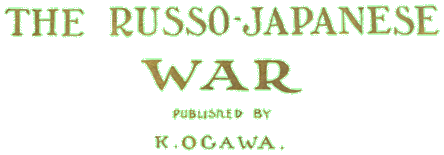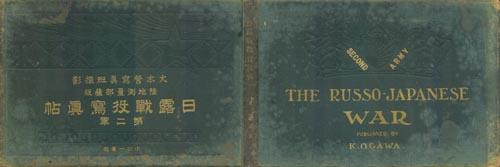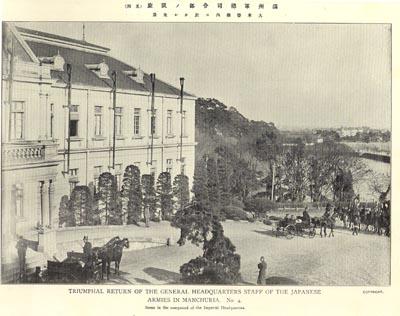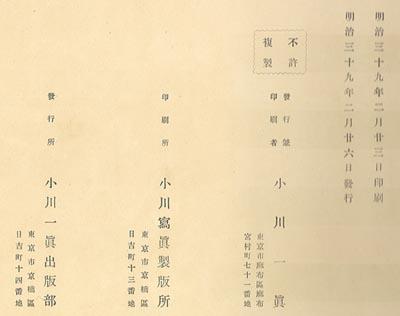|
~~ Second Army ~~ |
||||||||||||||||||||||||
|
Index for Russo Japan War, 6 Volume Set |
||
| Naval | Yalu & Karafuto Armies | First Army |
| Second Army | Third Army | Fourth Army |
|
|
||
| Covers | Colophons | Statistics |
|
|
||
|
Return to the K. Ogawa Main Page
For information on a similar 2 volume set, Click here. |
||
|
|
||

The Russo-Japanese War:
Taken by the Photographic Department
of the Imperial Headquarters
Second Army
Published by Kazumasa Ogawa, 1906
Part of a Six Volume Set

Second Army Volume
Ogawa, K. (Kazumasa) (Publisher)
The Russo-Japanese War: Taken by the Photographic Department of the Imperial Headquarters, Second Army, Tokyo, ©1904 by the Military Survey Department and published and printed by K. Ogawa, distributed by K. Ogawa, Tokyo and Kelly Walsh, Yohohama, Shanghai, Hongkong and Singapore, 1906, large oblong 4to (14 3/4 x 10 in - 37.5 x 25.5 cm), green blind stamped covers with gilt titles (boards and spine), listing of plates ("contents") and 36 pages of text in English titled "Operations of the Second Army" and 32 pages of Japanese text plus 178 numbered pages of photographs and 12 unnumbered plates. All plates are black and white halftone photographs. Each plate has an English caption and Japanese descriptive captions and notes.
Major Sections of the Engish Text Portion.
- Landing on Liaotung Penisula, May 6, 1904
- Battle of Mukden, February 19 Mar 10, 1905
For information on Kazumasa Ogawa, click here.
Complete Set of 6 VolumesThe Russo-Japanese War: A six volume set with continuing titles that read:
A matching set of 6 volumes, printed and distributed in 1905-6, large oblong 4to (14 3/4 x 10 in - 37.5 x 25.5 cm), green blind stamped covers with gilt titles (boards and spine), Tokyo, Naval volume copyrighted by T. Ichioka, 1904, Army volumes copyrighted by the Military Survey Department, 1904. An extensive photographic survey of the War dedicated to the First to Fourth Armies, the Armies of the Yalu and the Karfoto, and the Navy. The plates, which have descriptive captions, are supplemented by text pages (in English and Japanese) which reflect official Japanese military reports regarding the operations of the Navy and Armies in the Russo-Japanese War. The text accounts run in chronological order and recount the significant battles, operations and activities. In total the set contains 856 black and white halftone plates (736 - Army & 120 - Navy) produced by K. Ogawa, 136 pages of text in English, 123 pages of text in Japanese. Of the 856 plates, 11 plates fold-out and 14 plates have tissue overlays with descriptive information in Japanese. There is one loose map with the set. All 6 books have the same basic format. When read Western style, from front to back, the front cover is in English. It is followed (all in English) by the title page, the "Imperial Proclamation of War," text pages and finally a listing of plates. The English section ends next to last plate in the book. When read Japanese style, from back to front, the cover is in Japanese. It is followed (all in Japanese) by a title page, portrait plate(s) of Imperial family members in the military and key military members, the "Imperial Proclamation of War," text pages, a listing of plates in Japanese, and the plates with the last plate adjoining the end of the English portion of the book. All plates have descriptive captions in Japanese above the image and in English below the image. Plates in the Army books are numbered and there are plates (plates right after the title page) not included in the numbers. The plates are generally, but not always, printed back to back. The image area is approximately 7 x 10 in. The Army books share common plates (generally 10). These plates relate to the "Triumphal Return" of the Armies in Manchuria (8 plates at the back of the numbered plates) or they are portraits of commanders (2 plates at the front of the book). It is clear that the books were edited to not present images of horrors of war. I find very few plates that show the actual human carnage or death on the battlefield. In general the images show battles in progress, important locations, key terrain, key figures (both Japanese and enemy), captured ordnance and munitions, troops in combat and at rest, prisoners of war, first aid stations and hospitals, ships and military equipment and an occasional dead horse.
|
Illustrations in this Volume
(All Black & White Halftone Images)
Title Pages (English and Japanese)--- H.I.H Prince Nashimoto, Major
--- H.I.H. Prince Kitashirakawa, Sub.-Lieutenant
Calligraphic Title Page (same in all 5 Army volumes)
Below 2 plates in all 5 Army volumes --- Portraits (Field Marshal Marquis Yamagata & Major General Nakaoka)
--- Portraits (Field Marshal Marquis Oyama & General Baron Kodama)
(1} The Landing-place in Yenta Bay. (2) Cannonade of the Second Battery of the Thirteenth Field artillery Regiment from a hill north of Wenchiatun. (3) The wounded in the Depot Hospital in Tingchia-kiang near the Landing-place in Yanta Bay. (4) Japanese shells exploding at the Battle of Telissu. (5) Cannonade of the Fifth Field Artillery Regiment from the position cast of Sikow. (6) Funeral-service of the Thirty-fourth Infantry Regiment at Mamochuang. (7) Railway Transportation in the vicinity of Wangchiatun. (8) Cannonade of the Third Field Artillery Regiment from a field north of West Shuangting-shan. (9) Remains of a railway bridge destroyed near Wangchiatun. (10) The Field Telegraph Corps of the Sixth Division at work. (11) Outside the East Barrier-gate of Kaiping. (12) The Fortieth Infantry Regiment crossing the military bridge over the Hsiungyueh River. (13) A Russian prisoners of war.
(14) Examination of a prisoner of war. (15) Russian soldiers lodged in the Kaiping Hospital. (16) Building a bridge over the Kaiping River. (17) Defence-works on a hill north-west of Hsuchiatun. (18) Cannonade of the Third Field Artillery Regiment at Tashihchiao. No. 1. (19) Carts captured at Tashihchiao. (20) Cannonade of the Third Field Artillery Regiment at Tashihchiao. No. 2. (21) The wounded under treatment of the Medical Corps of the Sixth Division in a field at Linglingtun. (22) Quarters of the garrison at Yingkow after its Occupation. No. 1.
(23) Remains of the destroyed railway bridge over the Fuchow River. (24) The Japanese Military Administration Office at Yingkow. (25) Release at Yingkow of an army surgeon and his party who were prisoners of war. (26) Vessels gathered in the port of Yingkow after its occupation. (27) The Chinese police corps at Yingkow. (28) Rally of a part of the Eorty-fifth Infantry Regiment on a hill north of Kaiping. (29) Infantry and Artillery Regiments of the Third Division resting at Lichiatun. (30) The Thirty-fourth Infantry Regiment fighting on a hill north-east of Lichiatun. No. 1. (31) The Thirty-fourth Infantry Regiment fighting on a hill north-east of Lichiatun. No. 2. (32) Cannonade of the Thirteenth Field Artillery Regiment from a hill north-east of P'anchiatun. (33) The Forty-fifih Regiment advancing northward of Kaochiatun. (34) Funeral service for those killed at Telissu. (35) The Second Battalion of the Fifteenth Field Artillery Regiment advancing in the neighbourhood of Yihtaipao. (36) Cannonade of the Second Battery of the Six Field Artillery Regiment from the soulli edge of Hui-chuagtun. (37) Chinese carts with military stores crossing the military bridge over the Hsiungyuoh river, (38) Cannonade of the Fifth Field Artillery Regiment near Wangchiatun. (39) Advance of the Commander of the Twenty-fourth Infantry Brigade through Huichuangtun. (40) Remains of the destroyed railway bridge over the Fuchow river. (41) Japanese shells scattering near Wangmatai. (42) The Japanese Artillery position north-east of Ku-chiatsu. (43) Japanese encampment on hills near Punhankow. (44) Transportation of provisions stores on captured vans. (45) Outpost Headquarters near Shihmun to the north of Kaiping. (46) Preparations for Battle at Kaiping. No. 1. (47) Defence-works at Shihmun to the north of Kaiping. (48) Preparations for Battle at Kaiping. No. 2. (49) Japanese soldiers in the Kaiping Hospital. (50) Building a bridge over the Kaichow river. (51) A street in Kaiping. (52) Burning of the foreign belonging to the Russian Army at Tashihchiao. (53) Carts captured at Tashihchiao. (54) Quarters of the garrison at Yingkow after its occupation. No. 2. (55) Cannonade of the Second Battalion of the Fourth Foot Artillery Regiment from the northern edge of Douanjuan. (56) Wire entanglements at T'angwagshan. (57) Advance of a part of the Thirty-third Infantry Regiment north of Pakuakow. (58) Cannonade of the Second Battery of the Fourteenth Field Artillery Regiment from a field south-east of Dounanjuan. (59) Cannonade of the Japanese Artillery from the summit of a hill north-east of the Shaho upon Shou-shanpao and a hill on the south-east of it. (60) The Russian dead being carefully burried by Japanese soldiers on a hill south of the Shaho.
(61) The Sixth Divisional Bearer Corps bringing in the wounded outside the north gate of Kaiping. (62) Funeral-service of the Thirty-fourth Infantry Regiment at Mamochuang near Kaiping. (63) Advance of the Thirty-fourth Infantry and the Third Field Artillery Regiments near Pakuakow. (64) Advance of a part of the Sixth Infantry Regiment on a hill east of Lishantun. (65) Japanese shells exploding upon Russians occupying a hill west of Ilsinlitun. (66) Communication between dwelling-houses and trenches north of Ch'ienloutzu. (67) A view of Haicheng across the Shaho. (68) Trenches and trous-de-loups north of Ch'ienloutzu. (69) Railway station at Tashihchiao. (70) Japanese artillery position north-east of Kuchiatsu. (71) Russian trenches and the Eleventh Infantry Regiment on a hill west of Hsinlitun. No. 1. (72) Northward advance of the Thirty-fourth Infantry Regiment at Anshantien. (73) Accessory defences constructed at the foot of a hill west of Hsilitun. No. 1. (74) Russian defence position on a hill south-east of Hsilitun after its capture by the Japanese. (75) Accessory defences constructed by the Russians on a hill west of Hsinlitun. (76) Barracks at Haicheng. (77) The Sixth Infantry Regiment resting after the capture of a hill south of the Shaho. (78) Stalls for the horses of the Fifteenth Field Artillery Regiment in a wood north of K'ot'ouchai. (79) A fire at the Liaoyang Railway Station. No. 1. (80) The West Gate of Liaoyang on the day of its capture. (81) A part of the Sixth Infantry Regiment resting on a hill west of Shoushanpao. (82) Russian prisoners of war. (83) Engagement near the railway on the eastern edge of Wandzuyashuanshuzuy. No. 2. (84) Cannonade upon the neighbourhood of the Liaoyang Railway Station by a Battery of Captured Canet guns from the foot of a hill north-east of Shushanpao. (85) The Sixth Field Artillery Regiment struggling with the difficulties of the road north of Hsiangchiatun. (86) A detachment of the Forty-fifth Infantry Regiment fighting at Sungchiasant'aitzu. No. 1. (87) A detachment of the Forty-fifth Infantry Regiment fighting at Sungchiasant'aitzu. No. 2. (88) Japanese non-commissioned officers scouting in a millet-field north-east of Fengch'ipao. (89) The Third Battalion of the Thirteenth Infantry Regiment deploying near Erht'aitzu. No. 1. (90) Shells and cartridge-cases captured on the railway south-cast of Shuywanzuy. (91) Trenches dug along the railway north-east of Gudzuyazuy. (92) Defence-works of a part of the Twenty-third Infantry Regiment on a hill north-east of Sumat'ai, (93) Cannonade upon Liaoyang with captured mortars from the neighbourhood of Hsipalichuang. (94) A fire at Liaoyang Railway Station. No. 2. (95) Advance of a part of the Sixth Division near Fangchiatun. (96) Russian trenches south-west of Maetoun. {97) Japanese officers scouting on a hill north of Sumat'ai. (98) Engagement near the railway on the eastern edge of Wandzuyashuanshuzuy. No. 1. (99) Cannonade of the Third and Fifth Field Artillery Regiments from a south of the Shaho. (100) Russian shells falling near Heiniuchuang. No. 1. (l01) Cannonade of the First Battalion of the Fourteenth Field Artillery Regiment from a field north-east of Yuchiachuangtzu. (102) Temporary dressing station of the Twenty-first Infantry Regiment in a hollow south-east of Shao-yanzuy. (103) Loopholes made In walls on Ihe southern edge of Maetoun. (104) The Third Battalion of the Thirteenth Infantry Regiment deploying near Erht'aitzu. No. 1. (105) Headquarters of the Sixth Division on a hill at Shoushanpao. (106) The Third Company of the Sixth Engineers Battalion opening a road for the army near Sumal'ai. (107) Severe fighting of the First Battalion of the Twenty-first Infantry Regiment on a hill south-east of Shaoyanzuy. (108) Russian Forts and the Eleventh Infantry Regiment on a hill west of Hsinlitun. (109) A Russian, field gun captured north-east of Sung-chiasan-t'aitzu. (110) Russian officers, taken prisoners, sitting in front of the Gendarmerie Headquarters at T'aokuantum. (111) Observation post on the east side of the road on the northern edge of Houliuhotzu. (112) A street in Liaoyang on the day of its capture by the Japanese army. (113) The Japanese and foreign guests invited by an Army Commander at the former Russian barracks outside Liaoyang.
(114) The meeting of Japanese oflicers and foreign guests at the front. (115) The guard-house at Liaoyang Station destroyed, by a shell. (116) A railway bridge being repaired near Liaoyang. (117) The gorge of a Russian redoubt north-west of Shuywanzuy. (118) Trial destruction of a fort at Shuywanzuy near Liaoyang. (119) The barracks and other buildings of the Russian Army near the railway station outside Liaoyang. (120) The outer ditch of a Russian redoubt on the west side of the Liaoyang road and to the south-west of Shiguuan outside the West Gate of Liaoyang. (121) A position south-east of Erht'aitzu of the Sixth Battery of the Thirteenth Field Artillery Regiment. (122) Wounded prisoners being conveyed to the rear at T'ashanp'u. (123) Fight at Shihliho of a part of the Thirty-Fourth Infantry Regiment. (124) The Headquarters of the Second Army at Hung-paoshan. (125) Russian fire being concentrated upon a Jnpanese artillery position which extends from Ningkuantun to Wangchialaotzu. (126) A part of the Forty-Eighth Infantry Regiment advancing to attack at Huangwatien during the engagement about Chang-Lingtzu. (127) Cannonade of a battery with captured Canet guns from Panchiaopu upon the Russians to the southeast of Ssufangi'ai. (128) Fight of a part of the Forty-Fifth Infantry Regiment at Huanghwalien. (129) The wounded being conveyed to the rear during the Battle of the Shaho. (130) Cannonading of the Russians at Shahopu by the First Battalion of the Sixth Field Artillery Regiment at a point near Kanchiawatzu. (131) The Commander of the Third Division and his staff on a hill north of Hout'ai. (132) A bridge being built near Hunglingpu by the First Company of the Fourth Engineers Battalion. (133) A telegraph construction corps fording near Hunglingpu. (134) Preparations for wintering. (135) A captured rocket. (136) The Headquarters of the Eighth Division on the right bank of the Hun River during the Battle near Heikout'ai. (137) A Russian commanding tower standing in a brickyard to the north-east of Changt'an. (138) Engagement at a point north-west of Feits'aihotzu, (139) The Headquarters and the general supports of the Fifth Division halting at a point south of Yaoitzu. (140) Arrangements for the conveyance of the wounded over the ice on the Hun River. (141) The ammunition train of the Fifth Division marching over the ice on the Hun River. (142) The Temple of Kwanti (the God of War) on the western edge of Wuchiatzu, which was destroyed by Russian shells during the Battle near Heikout'ai. (143) Mukden, after its capture by the Japanese Army. No. 1. (144) Mukden, after its capture by the Japanese Army. No. 2. (145) A view of the interior of Mukden from its West Gatehouse. (146) Fight of the Thirty-third Infantry Regiment in a field north of Changt'an. (147) Fight of the Third Battalion of the Forty-first Infantry Regiment stationed on the Hun River to the .west of Changchuangtzu. (148) Attack of the Forty-first Infantry Regiment upon the Russians stationed to the west of Tachuangho. (149) The Russian communication depot at Suhupu after the retreat of Sis staff. (150) Russian railway materials left behind near Tawang-kiangpu. (151) Russian huts near Langchiapu. (152) The wounded being conveyed near Tayushupu. (153) Cannonade of the Thirteenth Field Artillery Regiment near Tsaochiatun. (154) The First Battalion of the Thirty-seventh Infantry Regiment fording the Hun River near Mochiapu. (155) A view at night of the burning of provisions by the Russian Army in the neighbourhood of Mukden Station. (156) The provision stores at Mukden which was burnt down by the Russians. (157) Marks of Russian shells left on a mud-wall of a village near Houmintun. (158) Remains of a Russian hut which was burnt near Tayushupu. (159) Mukden Station after the Battle. (160) Captured cartridge cases. (161) Japanese vedettes fighting near Peit'aitzu. (162) A view of the Hun River frozen near Heikout'ai. (163) Accessory defences between Likuanpu and San-hsuanchia. (164) Defence-works of the Eighth Engineers Battalion on the western edge of Litajentun. (165) The Russian Army Quarters at Mukden Station. (166) Prisoners collected on Lama Hill. (167) Entry into Mukden of Marshal Marquis Oyama, Commander-in-chief of the Japanese Armies in Manchuria. No. 1. (168) Entry into Mukden of Marshal Marquis Oyama, Commander-in-chief of the Japanese Armies in Manchuria. No. 2. (169) An observation-post on the eastern edge of Fuchia-chuang. (170) The hospital which was left by the Russian Army when it retreated for protection under the Red Cross Convention. (171) A chief of staff and other staff officers and the Japanese and Russian army medical corps in front of the Russian Red Cross Hospital at Mukden. (172) A public office in the Castle of Mukden. (173) Firing at Pinglofut'ai. (174) The opening of Tahsuan Bridge over the Hun River. (175) Trophies taken at Mukden (small-arms and ammunition carts). (176) Trophies taken at Mukden (baggage wagons). (177) Trophies taken at Mukden (entrenching tools). (178) Marshal Marquis Yamagata inspecting positions in the neighbourhood of Changtu.
---- Marshal Marquis Yamagata Being Welcomed at Mukden
---- Marshal Marquis Oyama, Commander-in-Chief of the Japanese Armies in Manchuria, and His Staff
---- Major-General Fukushima, The Japanese Commissioner for Arranging an Armistice, on His Way to the Meeting-Place of Commissioners
---- The Meeting of the Commissioners Appointed to Arrange Armistice
---- Triumphal Return of General Headquarters Staff of the Japanese Armies in Manchuria. No 1.
---- Triumphal Return of General Headquarters Staff of the Japanese Armies in Manchuria. No 2.
---- Triumphal Return of General Headquarters Staff of the Japanese Armies in Manchuria. No 3.
---- Triumphal Return of General Headquarters Staff of the Japanese Armies in Manchuria. No 4.

Dating the book.

The two rows of characters at the far right indicate the following (going from the right row to the left).
- Meiji 39 (1906), February 23 - Printed
- Meiji 39 (1906), February 26 - Distributed
|
Index for Russo Japan War, 6 Volume Set |
||
| Naval | Yalu & Karafuto Armies | First Army |
| Second Army | Third Army | Fourth Army |
|
|
||
| Covers | Colophons | Statistics |
|
|
||
|
Return to the K. Ogawa Main Page
For information on a similar 2 volume set, Click here. |
||
|
|
||